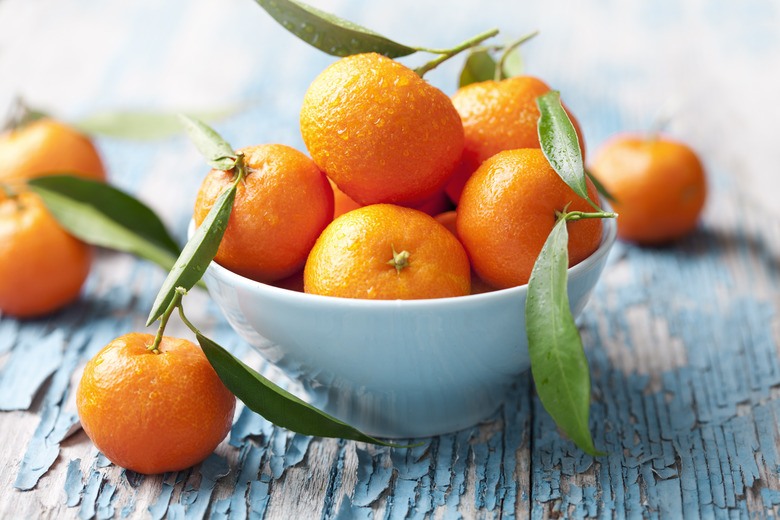Types Of White Fungus On Citrus Fruits
We may receive a commission on purchases made from links.
If you live in an area where citrus trees can be grown successfully, it's a no-brainer to have a few around. Their blossoms are beautiful and fragrant, the trees themselves are aesthetically pleasing, and of course, you'll get a steady supply of citrus for eating fresh, for preserving, and for use in cooking and baking. Unfortunately, citrus fruits are vulnerable to many pests and diseases, especially if they're also grown commercially in your immediate vicinity. White stuff on an orange skin, for example, is usually a sign that you have a fungus problem.
White Dots on Fruit
White Dots on Fruit
You may find that your fruit is infected with both white and colored fungi at the same time. Often, they're the same pathogen but at different stages of development. This is the case with melanose, a fungal pathogen you'll find primarily on grapefruit and sweet oranges. Melanose colonizes dead twigs, and its spores spread when rain hits the twigs and splashes those spores onto the fruit. As you'd expect, given that it travels by splattering, the fungus shows in the form of dots on the fruit.
Initially, those dots are white but then they mature to brown. The good news is that melanose isn't harmful to the fruit; it just looks bad. It scrapes off easily with a fingernail, and you can still harvest and use the fruit as usual. You can minimize the risk of melanose in your trees by pruning away dead twigs (they're frequent after freezing weather if you live at the limits of citrus-growing territory). If your tree has a history of melanose problems, you can apply a liquid copper fungicide once the fruit reaches a half-inch or so and every few weeks after that.
Fuzzy White Fungus on Citrus Skin
Fuzzy White Fungus on Citrus Skin
Another example of color-shifting fungus on your citrus comes from green and blue molds in the Penicillium family. These can attack the fruit while it's on the tree or after harvesting, but in either case, they establish a foothold wherever the fruit's skin is damaged. A fluffy white mold appears first and then changes to blue or green as the mold matures. Like botrytis on grapes, it draws moisture from the fruit and causes it to wrinkle and shrink.
If you should see this on fruit still in the tree, remove and destroy them immediately (or put them in the trash but not the compost). Commercial growers typically protect against this pathogen by giving the fruit a fungicidal bath after harvest, but at home, you have the luxury of handling the fruit individually and with a lot more care. Separate any that have a damaged skin and eat those first and then monitor the remainder closely for any mold activity. If you spot some, discard those fruits immediately.
Brown Rot, or Phytophthora
Brown Rot, or Phytophthora
Another common fungus plaguing citrus fruit is phytophthora, or "brown rot." You'll see this mostly in times of frequent rainfall (or occasionally if you've been irrigating with a bit too much enthusiasm). Again, this fungus starts as a white fuzz and then rapidly evolves into soft, brown decayed spots on the skin. You'll see this mostly on the undersides of the frui, and mostly on the lowest branches because the spores are soil-borne and reach the fruit in the form of splashes. Once it's in the tree, spores can also be spread by the wind.
Since it affects wet fruit, you can reduce the risk by pruning your trees to an open structure for improved air circulation and by pruning the lowest branches to at least 2 feet above the ground. If you use a sprinkler to irrigate, adjust it so it doesn't splash into the fruit. Remove any fallen fruit from under the tree as soon as possible and only harvest fruits for consumption or storage when they're dry. For extra protection, you can use a liquid copper fungicide spray. Apply it to the ground under the tree (that's where the spores are) and then to the lower 4 feet of the tree itself. Spray up from underneath to get the underside of the branches, leaves, and fruit.
References
- University of Florida IFAS Extension: 2021-2022 Florida Citrus Production Guide: Melanose
- Texas Agricultural Extension Service: Diseases Affecting the Fruit – Part 2
- University of California Statewide Integrated Pest Management: Citrus – Diseases and Disorders of Fruit
- Humboldt & Del Norte Master Gardeners: Phytophthora Brown Rot of Citrus – Something to Look Out for This Fall and Winter
